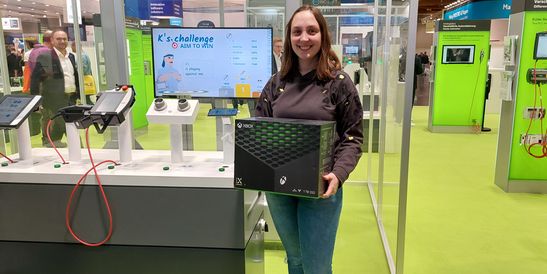OPC UA: Future-proof for machine manufacturers?
- Automation
- Digitalization
- 13.6.2023
- Reading Time: {{readingTime}} min
- Share Article

Contents
In today’s world, the requirements of plant and machine operators overlap almost completely in certain key areas. Greater flexibility, greater intelligence, and more autonomy are at the top of the list. Implementing these demands requires, among others, more modular functions and extensive data exchange—between different modules, individual machines, multiple systems and beyond that with MES and ERP systems and even with suppliers and service providers in the framework of newly emerging ecosystems.
The constantly advancing OPC UA communication platform has become an essential tool for fulfilling these requirements. Using standardized models, it enables the exchange of data between an individual machine and the entire production landscape and beyond.
This standard is evolving constantly and at high speed. At various bodies in the industrial sector, such as the German Association for Mechanical and Plant Engineering (Verband Deutscher Maschinen- und Anlagenbau, VDMA), numerous standardization committees work on expanding OPC UA with new functions and information models.
New Companion Specifications are being published on a regular basis, and even existing standards such as PackML and Euromap have been transferred to the OPC UA model. This is not always unproblematic. It became evident that some of the Companion Specifications overlapped in some of their definitions. For this reason, higher-level committees work on harmonizing such conflicts.
Real-time communication down to the field level
On the other hand, new functions and capabilities are constantly being added. One example of this is the UAFX extension, which made it possible to extend the basic OPC UA functions to communication at the field bus level. The challenge here was the inclusion of devices with limited memory and computation capacities.
Once the inclusion of low-level data from sensors and actuators had been accomplished, a desire to cover even more data emerged. Previously, only aggregate data, alerts and outliers have been transmitted, but the users of AI-based services are now looking for the continuous transmission of unaltered raw data. However, this must not interfere with the operation of the machine. In order to achieve this, various industry and IT providers created a working group whose goal it is to push forward OPC UA over TSN (Time Sensitive Networking). It is focusing on efficient, intelligent and secure industrial field devices compatible with OPC UA FX (Field eXchange).
In this manner, the standards enrich each other: OPC UA drives the utilization of TSN forward. However, establishing a real-time enabled network is not easy. Typically, this can only be achieved through close cooperation with the OEM and the maker of the control system so that all obstacles and bottlenecks can be addressed. At the same time, the new 5G mobile data standard is also being adapted to TSN, creating new, simpler opportunities. 5G allows the almost instantaneous transmission of large data volumes, which in turn facilitates the use of edge servers for complex AI control operations.
“Ten lost years”
It bears remembering though: Industry 4.0 is a promise that so far has not been kept. The idea was that more intelligent, more flexible machines, smart factories and predictive services would make production more efficient and less resource-intensive, allowing plant operators to benefit from higher profits, and end users from lower prices. Apart from a few isolated lighthouse projects, however, this effect has not been evident across the board.
At the Mechanical Engineering Summit in Berlin in October of 2022, Michael Finkler, chairman of the VDMA Association for Software and Digitization, rained on the Industry 4.0 parade. The productivity in the industrial sector was at the same level as 2011, and productivity in machine engineering even declined in this period in spite of consistently high utilization, said Finkler. In the ten years that have passed since “Industry 4.0” was proclaimed at the Hanover Fair in 2011, there has been “zero progress in productivity”, he added.
However, Finkler did not think that the technology per se was the problem, but rather the poor implementation. While users did drive forward standardization and thus created the technology basis for a powerful Industry 4.0, Germany fell behind in the development of the industrial platform economy—and this means “ten lost years”, according to Finkler.
Other actors, he added, focused on creating industrial platforms, in particular US-American corporations. Fritsch named Amazon, Google and Microsoft as examples of corporations who focused on driving the collection and analysis of data in the industrial sector.
Next level: platform economy
And it is true, no global offerings have been developed in Germany so far. At least, however, sector-specific platforms do exist. The prime examples here are the UMATI platform in the machine tool industry and the Catena-X network in the automotive sector. They are based on the OPC UA communication solution and continue the standardization at a higher level. A close collaboration between major players from various sectors, industry associations, IT associations and political actors is now undertaking the mission of driving a global platform economy in the industrial sector.
At the German Digital Summit in Berlin in early December, the actors used the opportunity to push the “Manufacturing-X” project. Its goal is to create a common data space for the industrial sector in which all actors in the value creation chain will cooperate. The major items on the Industry 4.0 platform agenda are:
Reorganize value creation networks and respond quickly to disruptions (resilience)
Enable new business models, a closed circular economy and increased efficiency (sustainability)
Digital innovation to secure and expand the global leadership position of German industry (competitiveness)
Manufacturing-X is not only targeted at major corporations and large concerns but also intends to include small and mid-sized enterprises and enable them to also benefit from the digital transformation. In particular small and mid-sized enterprises (SMEs) worry greatly about losing their interface with customers, says for example Hartmut Rauen, Deputy Executive Director of Machine and Plant Engineering Association VDMA . On the other hand, it is also obvious that business relationships and models will continue to change. Manufacturing-X is therefore intended as a platform that creates the trust required to share data along the supply chain and make innovative services possible.
The only German software provider who can take on the mentioned US corporations is SAP, who is cooperating closely with the German industrial sector in order to establish a German or European platform aside from the American competition. The planned cloud platform for the manufacturing sector is still under development, but it is drawing for example on the experience of the Catena-X network.
As a cross-sector platform, however, it must handle much more complex processes, not just in manufacturing but also along the supply chain, for example. Ultimately, the crucial goal is always to provide the most efficient data exchange. For this reason OPC UA, too, will gain a foothold in this domain.
In addition to the automotive sector platform, Manufacturing-X also corresponds with other platforms. For example, it includes GAIA-X, the decentralized data platform developed as a common European project intended to create an alternative to US-American cloud providers. In the framework of the SmartFactory-KL project, this also includes the development of smartMA-X, a use case of the Gaia-X subdomain Industry 4.0 .
OPC UA will continue to provide a broadly accepted technology foundation
Keeping future-proof in mind
OPC UA itself as well as the associated use cases, applications and higher-level services in the area of platform economy are subject to rapid change, as we have seen. This makes it all the more important to use the right tools and partners to be on the safe side now and in the future.
KEBA made the conscious choice to go with open source software for its modular automation suite in order to be able to always keep up with new developments. Users of manufacturer-specific SDKs are always dependent on the manufacturer and whether or when they will implement new extensions and functions. Using open source software gives KEBA the freedom to develop missing extensions together with the community or do its own implementations. Joint working groups can achieve usable solutions within a few short weeks. With commercial SDKs, on the other hand, the implementation of new features and functions can take six months or a year, depending on the supplier's agenda—if it happens at all.
Aside from these technology risks, there are also business risks, because the licensing models come with limited or no support for reseller models. As a result, a machine manufacturer’s customers may find themselves forced to purchase their own licenses from the SDK provider.
Conclusion
It is almost impossible to tell where the standardization development will lead in the future. One thing is for certain though: OPC UA will continue to provide a broadly accepted technology foundation enabling the universal data exchange within companies and along the value creation and supply chains. The platform economy, which is still in its infancy in the industrial sector, needs precisely these functions—and thus secures the future relevance of the communication solution.
Machine manufactures can therefore trust that their investment in the know-how and the corresponding tools will not turn out to be a dead end. It is also important to remain open to further developments, and to find partners who will support this openness with tools that are just as open.


























